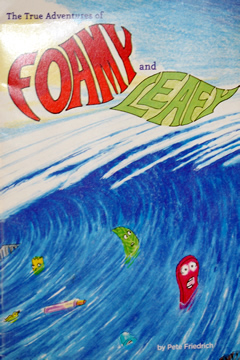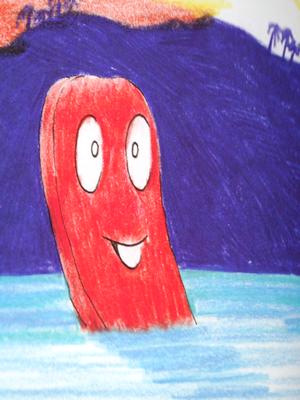Book Review: The True Adventures of Foamy and Leafy
Foamy and Leafy is a kids’ book about the plastic in the North Pacific Gyre. This review is a guest post by plastic-free blogger, Linda Anderson, who blogs at Citizen Green http://tippecanoegreen.blogspot.com. She’s filling in for me today while my eyes heal. Please stop by her blog and leave comments or suggestions.
 Several months ago I was surfing the web to find children’s literature about the issue of plastic debris in the ocean and I came across this comic book called, The True Adventures of Foamy and Leafy. Foamy and Leafy are two pieces of colorful plastic foam that were glued to a Halloween pumpkin by a child. The pumpkin rotted and decayed, but the pieces of plastic, being very non-degradable, blew away with the wind.
Several months ago I was surfing the web to find children’s literature about the issue of plastic debris in the ocean and I came across this comic book called, The True Adventures of Foamy and Leafy. Foamy and Leafy are two pieces of colorful plastic foam that were glued to a Halloween pumpkin by a child. The pumpkin rotted and decayed, but the pieces of plastic, being very non-degradable, blew away with the wind.
Foamy blew into a small creek and eventually ended up in the Atlantic Ocean. She actually floats through the Panama Canal and ends up in the Pacific Ocean. Leafy blew away and got stuck to a truck tire. The tire eventually ended up in Long Beach Harbor in a pile of old tires that was supposed to keep the ocean waves from eroding the beach. Leafy and Foamy actually find each other in the North Pacific Gyre. This is where they float and circulate slowly for many, many years. They meet all sorts of other plastic items like bag ties, Barts (Simpson), hotel shampoos, bath toys, and yoga mats. You name the plastic item – it’s out there. The sun and the wave action begin to fade and harden the our foam friends and, of course, they begin to break apart.

You need to read it yourself to find out what else happens to Foamy and Leafy. The comic book format is a fun and engaging way to interest kids in the issue of the plastic debris that is choking all of our oceans. If a piece of plastic has a life of 500 years and a human generation is 35 years (according to my geneticist husband) then that piece of plastic will be there for 14 generations – for your great, great, great, great, great, great, great, great, great, great, great, great, grand children.
Obviously we must educate our children about this issue and they will need to educate their children. The back cover of this comic book has lots of information and great suggestions for kids. It’s up to us, the adults, to help kids avoid disposable plastic and to teach them to care for the planet.
The True Adventures of Foamy and Leafy is written and illustrated by Pete Friedrich and published by Paved Planet.








This is one of the major problem nowadays for this world that is use of plastic. I certeainly agree this article. I think every ones should think something about how to stop polluting environment by stop using of plastic materials.
Bryson, I just have to reply to your comment even though I am hesitant to promote a endless argument. I noticed that you imply fear and myths to be the basis of the issue of disposable plastics. I read your blog and, you are correct, there are many uses for modern plastic. The issue in my guest blog is that the incorrect disposal of plastic is causing a huge pollution problem in the ocean. There are many groups doing scientific inquiries into this issue including the Algalita Marine Research Foundation (algalita.org) and Sea of Change with Joel Paschal. Beth Terry and I both blog about the issues involved with the misuse of plastic. We do not base our writing on “something we heard” – we research it. Some things may be wrong but the same can be said of scientific findings.
I agree, Beth. Wrapping yourself in plastic clothing may appear to keep you warm, but these “miracle” fabrics are all derived from petrochemicals which are known carcinogens. So no matter how you spin it, you’re skin is in contact with a cancer-producing material all day and possibly all night.
Wool and cotton and other natural materials do a better job than any synthetic, with none of the lethal side effects. And the production of these items doesn’t clog our rivers and oceans with the plastic waste stream from synthetics production, that is not-so-gradually kililng everything in its path.
Bryson, that post is so scary. The thing is, “green” is more than just saving energy. It’s also reducing toxic chemical exposure. And I fear that many of the plastic solutions we are turning to to reduce emissions are poisoning us.
Hello all,
For those of you curious about the age range, I’ve taken the book to many middle schools to present it and had best luck with 5th-8th graders. The language in the storyline is appropriate for that reading level, and the more detailed info in the back is suited for the older grades and/or the teachers / parents involved. The back of the book also has a short bibliography and a list of several very good websites.
Thanks for your support and interest!
I’m putting in a purchase request for this at the Seattle Public Library system! 🙂
I think the reading level is middle school level. A 7 year old might need some help with it but remember a comic book has lots of illustrations which help out a lot.
What reading level is this at? My nephew turns 7 soon and his backyard is a bayou so he should be aware of this stuff. Thanks for the suggestion!
food for thgt for the genZ
Thanks for this review. I would love to get this book and read it to my granddaughter.